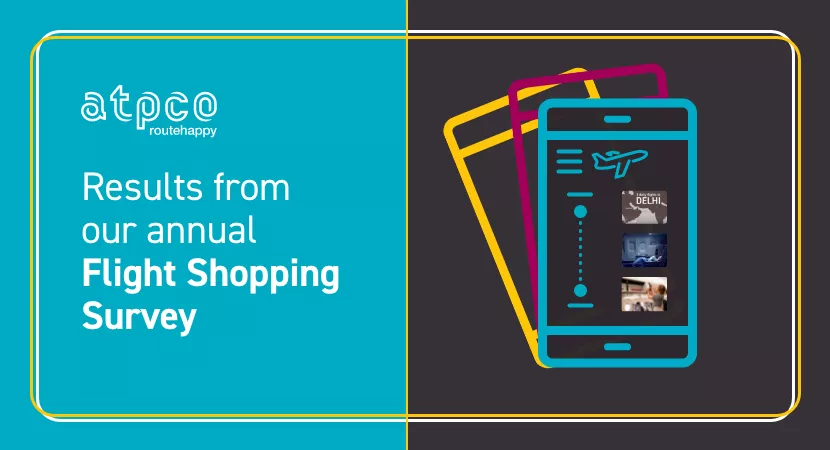On demand | Elevate 2022
A retailing journey: An in-depth look at Expedia’s success and learnings
INTERVIEW • MERCHANDISING
High airline retailing success, low difficulty level. Hear from Expedia Group about how they have enhanced their airline retailing game over the years: they evolved their shopping platforms by adding more content and focusing on the customer shopping experience. Learn from them on how you can up your own retailing game.
Ellen: Welcome, Connie. So, we’re happy to have you here with us—joining us at Elevate. We’re going to talk a little bit about retailing. Expedia Group has been a retailing leader in the travel industry for a while.
So, we were talking back earlier about our time with the various OTAs and Expedia just has continue to enhance their online presence by evolving their shopping platforms. We're excited to hear about this journey, how it started, where it is led, to where Expedia is today. So, let's get started.
Alright, so question number one. Retailing and merchandising has been important to Expedia group since the very beginning, and as a relationship with ATPCO, you were one of the first channels to adopt the Routehappy content back in 2014. You're also one of the first channels to launch the scores and amenities content. Tell us a little bit about that journey and successes that you have seen from early on when you first started.
Connie: You know, anytime content is available that helps our travelers make a better decision… we want to use it. So much of our product development lifecycle is about looking at how travelers are using our site.
We look at everything from how they progress down, what we call funnel progression or scrolls down the page, and look for, hey, is anyone getting stuck somewhere?
Is there a way we can make this easier, this decision easier on how to shop and buy flights? And so, much of our process is grounded in that. We're doing everything from research, regularly, and looking at measuring things like delight of our travelers as they're using the site, the usability of our sites, and also trust factors, like, are we helping them trust that what we're presenting is the most accurate and useful information for our travelers. And so, that's where things like scores and amenities really help travelers gain confidence in booking. And so much of that process we're iterating on every day.
So, utilizing research, then funnel into how we get something live on our websites, and, as we're doing that, we're constantly looking at all the data and having our analytics team run things to make sure that we are able to test and see, yes, this thing that we just launched was able to meet the success criteria that we have for this. And that can range from anything from converting a customer to just funnel progression to someone returning back to our site and still being interested in booking. So, those are all things that we look at to help decide.
Ellen: Interesting. During the pandemic, ATPCO created reassurance UPA content for the industry to communicate health and safety protocols implemented by airlines, which were then developed into structured UPAs. Expedia Group helped inspire this after realizing that consumers wanted to visually see more content during the booking process to help them feel safe while flying. Why did Expedia Group feel that the structured data was so important? And do you think that the pandemic contributed to a pivotal shift in thinking within the industry and the way people shop for flights?
Connie: I mean, COVID has changed everything for all of us. All of us. My family just went through our first bout of COVID just a month and half ago, and everyone was stuck at home. I have four kids and they were all stuck at home, not at school. But yes, for the industry, I mean everything changed.
We were all collectively trying to handle these mass relations and changes and had never planned to do this all at the scale that we were. At the beginning of COVID, I think we were, at one point, navigating over 3,000 unique airline policies that were all changing as time was going on. And we have over 500 airline partners.
So, this is why that structured data is so important for us. When we are operating globally, for someone to be able to say, hey, one airline might say we've cleaned our airplane between flights and one might say I've sanitized it, and someone else might say the air is purified, and with different cultures and different linguistic preferences, we need to be able to take something that people can understand globally, to have that confidence to come back and fly again. And thankfully we're seeing that now.
Ellen: And deliver it at scale.. Moving on to the next question. Earlier this year, Expedia Group announced their new strategy to serve travelers partners in the industry. One of the components of that strategy is smart shopping, which puts the traveler experience at the core of everything. What has changed or influenced Expedia to adopt this new way of thinking to transform the shopping experience?
Connie: Smart shopping for us really means value-based shopping, or I think as some folks call attribute-based shopping, and that is something we're incredibly focused on across all of our different product areas that Expedia. It's already live on our lodging path and it's coming soon for air.
Value is very subjective, right. What I care about for coming here for this business trip to DC, and what I value on that flight that got me here, is completely different than my flight to San Diego to go to Legoland this Thursday.
Ellen: With four children.
Connie: With four children who are all elementary school ages, right? So, what I want is very, very different. What I value in booking that flight is completely different than a business trip and being able to personalize that for our travelers in the context they're in is what is what smart shopping encompasses, right?
So, being able to say, hey, based off of your interactions with our site, the information you're giving me about this travel that you wanted, the search that you're doing, how can we make sure to surface the things that are going to matter most for you so that it's easier to go shop and search for the flight that you want to take?
What we've done throughout this past year is tons and tons of research around ensuring that we aren't just thinking about things the way our industry collectively has always thought about it.
Earlier some folks were mentioning, we've gone from a schedule-based to a price-based search and what's next. And that's really what we did. We took our research team and have done over six months of research in our iterations to just start from zero and say, if it weren't just schedules and price, how else would people want to shop?
And we've done those iterations with many, many, many different travelers to try to identify the best way to bring that information forward—the value or the attributes forward. And so, you can see in this slide, this is just an example of what could be to come, but what we've done here is showcase, like, we've been working this whole year on bringing attribute data up the funnel.
So, bringing you know ancillary data, could be seats and bags, it could be more in the future. I know that tends to be top of mind, but it can be everything from lounge access to Wi-Fi, meals, that is all as we've brought each item up front in the final higher up and to get that transparency for travelers.
Every single test that we have launched this year has been an increase in non-restricted fare purchase. So, we know that we are now able to kind of blur the lines of what was traditionally held as a, “Oh, you know the premium class bookings are going to tend to be business travelers,” we're seeing that coming in with leisure travelers, and it's because we're able to showcase all the value that is coming for different fare types further up funnel.
So, yeah, this is not live right now, but we do prototypes. As we're iterating and doing research, our design teams create prototypes that we run in front of travelers, and this is one example of a prototype that we ran at our Expedia Group conference in May called Explore.
And so, you can see there's a lot of focus on visual content to help drive the differentiation. And as the industry is focusing on having differentiated products, our goal is to make sure that it's really clear what those difference are so, you know, eyes wide open what you're buying.
Ellen: That's fantastic, just having all that information, just being transparent to customers. Okay, question four. I'm managing all my pieces. So, what experience or content does Expedia group see as transformative in the new smart shopping way of displaying flights?
Connie: I think a couple folks mentioned this earlier when they were highlighting the goals for ATPCO going into 2026 and talking about having those standard attributes fed in. I think what is really key for us, and what we've been testing throughout the year, I mentioned earlier, is making sure that we pull forward all these different attributes that help differentiate each different fare.
So if we can pull that as far up in the funnel as possible, we're helping travelers understand early, early on what they're going in for. So, instead or, I always use this example today, people are going search, search, search… as they go down the path, get to check out, literally, we see customers or travelers taking notes still with pen and paper jotting down, ohh, this is this flight’s information. And then I'm going to go back up, and search another path, right. And it's this arduous process that hasn't changed in many, many years.
And so, we want to bring transparency to the prices, the availability of ancillaries, along with the fare types, so that people can make these decisions early on and be able to see what exactly they're going to get.
Ellen: I can imagine looking at the whole trip is critical as well. So, I just know I've been with that piece of paper scribbling flights, and then I go look at the hotel, and then I go think about the car, and then try to pull it all together. And where you can sort of take this, and actually make it holistic, becomes even more beneficial.
Connie: Right, that notion of smart shopping, like I mentioned earlier, we're obviously talking about air right now, but it applies all of the different product areas. We kind of bring those all together with trip boards so that people can have an integrated view of how they shop for and plan for a whole trip.
Ellen: Alright, our last question, what would you like to say to airlines and channels in this room in terms of evolving industry needs and retailing? Any advice, or comments, or pitfalls?
Connie: Yeah, I think the most important thing is that we put traveler experiences first. So, if we are all focused on the traveler’s experience, the traveler wins, the carriers win, the whole industry wins, right, because travelers are going to have this wonderful experience that's going to make them want to travel more.
We've seen, I think we called it “revenge travel” right after, when travel is picking back up after two years of everyone sitting at home, but we saw people eager to go back, come back, and explore new places. And so, if we focus on that experience for travelers, it doesn't become this pain point.
For a lot of folks, we've seen like oh, the airplane part of it is just get me to where I want to go, and then the good part starts. And we don't want that, right? We want the whole experience, from the moment you leave your home, to be a wonderful experience. And so, if we're focusing on those travel experiences, not just, we talk a lot about shopping here, but we look at end-to-end experiences, even the servicing part of it, right? Like, how do we make sure if there are interruptions that we can actually still delight travelers when it comes to servicing and changes and cancellations?
As part of that, to be able to do that successfully as an industry, we need to be able to have all of the data available, whether it's pricing data, content availability, having all of that data available ensures that we can surface all of those attributes to the travelers as early as possible, so they know exactly what they're going to get.
Ellen: We have a little bit more time, so I'm going to ask one more question. What time are we leaving for Legoland and when are we going?
Connie: I'm cutting it close this time. I'm going to be home for two hours after I get back from DC, before I leave for San Diego. So, fingers crossed my flight schedule doesn't get…
Ellen: That's right, exactly. I have never been, and I heard it's fantastic, and I'm not a kid, so. So, alright, we've got a little bit more time. I know we're not set up for questions on this panel, but is there sort of one question, or anything anybody wants to add to the conversation?
Richard: Richard Raleigh with Saber. So I noticed... well, thanks first of all for sharing the information about your success with improved conversion rates. I noticed you highlighted your mobile app. And I was just wondering, are your customers nowadays, are they predominantly mobile or mainly on the computer?
Connie: All of our designs are done on mobile experiences. As you can imagine, that's the most limited space, right? And so, we ensure that whatever design we put together, if we focus on an app-first experience, we know that then we can scale to web. So, that's why you see that design now.
I don't think I can share the exact percentage, but absolutely, we've seen a shift over the years of moving from web to tablet to app, and it varies depending on different regions. So, some cultures will definitely see, in some regions, you see a heavier adoption of app usage. And so, we are definitely focused on having folks move into the app and the reason we do that is because we know that the app users are stickier and are higher converting, right?
There are different features we can enable, when you think of our Expedia app in our example, being like your travel agent in your pocket. It’s not just about the booking, but also, how can we assist you through your trip? So, anyways, there’s a heavy focus on being app-first in our product and technology teams.
Ellen: Alright well, thank you Connie for joining us today. So what a journey it's been for Expedia over the years. The story is inspiring and we can't wait to hear more about smart shopping as we go on.
Connie: Yeah and tomorrow, I think one of the breakout sessions, I'll be walking through an entire demo of the whole path end-to-end if you want to see more, join us.
Ellen: Well, thank you.
Connie: Thank you.
An event experience you can't miss
ATPCO's Elevate + ARC's TravelConnect
Speakers

Ellen Lee
Chief Product & Marketing Officer, ATPCO
Ellen brings more than 20 years of experience in airlines and hospitality to ATPCO. Ellen started her career at American Airlines and Delta Air Lines in pricing and revenue management. At Orbitz, she helped to found the company’s business plan and eventually served there as Vice President, New Ventures & Business Development. Ellen co-founded G2 SwitchWorks in 2004 with ATPCO CEO Alex Zoghlin, building a low-cost, feature-rich online travel distribution platform. Since then, Ellen held senior leadership roles at ADARA, Hyatt, and Alterra Mountain Company. She holds an MBA in Marketing and International Business from the University of Chicago’s Booth School of Business and BS degrees in Economics and Finance from Marquette University.

Connie Chung
Senior Director, Air Experiences Product , Expedia Group
You might also like



